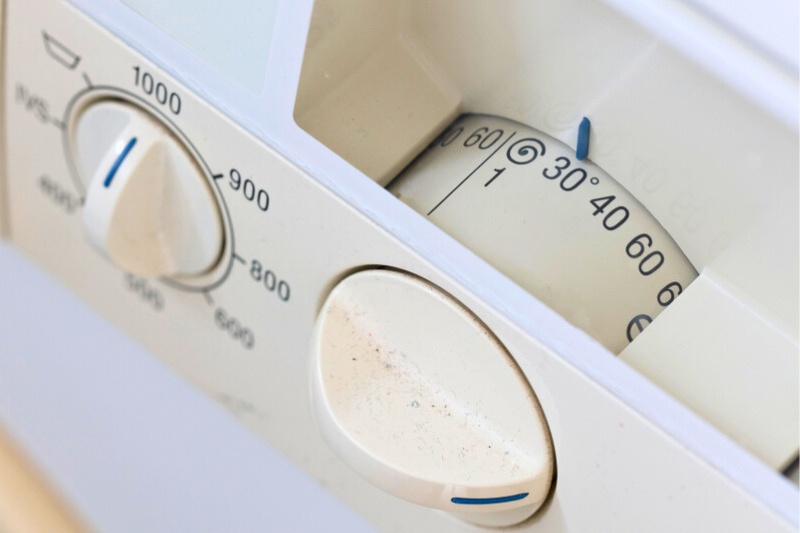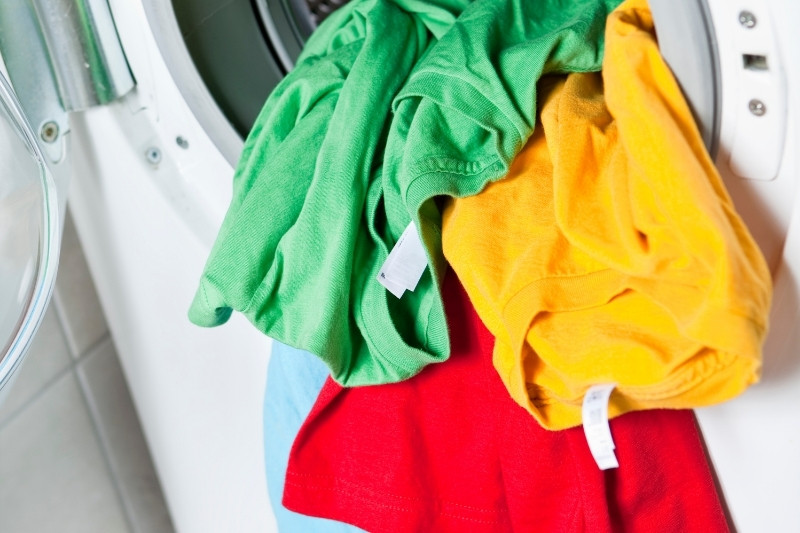One of the most common questions that comes up when doing laundry is whether to wash coloured clothes in hot or cold water. And the answer can have a significant impact on how your brights look post-wash.
Many people believe that hot water is necessary for a thorough clean and to remove dirt and stains. Meanwhile, others swear by cold water to prevent fading.
So what is the correct way to go? In this article, we’ll explore the key things to consider when choosing which temperature to wash your coloured garments at. Plus some simple tips to prolong their vibrancy while you’re at it.
The Impact of Water Temperature on Coloured Clothes
Wondering why selecting the right water temperature is so important? Well, the reason is that when dyed garments get wet in the washing machine, the colour can bleed out of them.
This is more likely to happen in hot water, which relaxes and opens the fibres, allowing dye to escape.
As such, your coloured clothes could continue to fade when laundered. This will be especially noticeable on darker shades.
However, by opting for a cooler cycle, you can reduce the risk. Not to mention prevent different colours bleeding into one another in the wash.
What is meant by a ‘cool cycle’?

While a standard wash cycle typically cleans clothes at 40°C, cool cycles run at 20°C or 30°C.
20°C uses the least energy and is suitable for very delicate items, but only if they’re only lightly soiled. You may also find that powder detergents don’t dissolve well at this temperature.
With that in mind, the more versatile 30°C setting tends to be the go-to option when seeking a lower water temperature.
Ideal for bold garments, as well as those prone to shrinking like wool, many people also use 30°C cycles for everyday laundering.
Meanwhile, 40-60°C is reserved for more heavily soiled items, plus sheets and towels that need a deeper clean.
Should You wash Coloured Clothes in Hot or Cold Water?
While choosing a temperature may seem simple, it’s actually more nuanced than that. In fact, there are several things you should ask yourself when choosing between a hot or cold water wash cycle.
Read on to learn how and why these factors should impact your decision.
What does the care label say?

The first thing to check is the care label. You want to make sure that the item of clothing is safe to machine wash, and if so, at what temperature.
If a 30°C or ‘cold water’ cycle is recommended, then you have your answer. Otherwise, if 40°C is the maximum suggested temperature, you’ll have to use your judgement when it comes to colours.
But there may be other clues on the care tag too. For example, if it says, ‘wash before wearing’ or ‘colour may run’, then this points to a risk of colour bleeding. In this case, always select a cool wash cycle.
Tip: when checking tags, you may notice that an item is marked tumble dryer safe. However, drying colours indoors on an airer (away from sun and heat) is the best way to prevent fading.
What material is it made from?

Another element to consider is the material. For instance, if the item is made of wool or a delicate silk-like material, you’ll need to use cold water, regardless of the colour.
This should be noted on the care tag, which will likely also suggest a delicate cycle.
Cotton and polyester, on the other hand, can generally be washed safely at the warmer temperature of 40°C and with more agitation.
However, coloured cotton is more likely to fade versus polyester due to its porosity. So, it may be worth turning down the temperature to keep it brighter for longer.
Tip: worried about cotton or denim bleeding in the wash? Then why not try to set the dye pre-wash? Simply soak the item in a bowl of lukewarm water with half a cup of salt for 30 minutes.
Is the item brand new?

Something else to bear in mind is whether the garment is new. This is because any significant fading is most likely to happen during the initial wash when excess dye is removed.
The dyes in well-worn items that have been laundered several times are typically more stable.
Again, check to see if the care label recommends washing before wearing and make sure you do!
Otherwise, excess dye might stain your skin and other clothes you’re wearing. The most common culprits are dark wash denim jeans like indigo and black styles, and bold red items, so wash these on their own to start with. And stick to cold water to help retain the colour.
Tip: To prevent dark colours fading and keep colours bold, try adding half a cup of white vinegar to the rinse cycle. Use instead of fabric conditioner to break down any leftover detergent residue and your clothes will look brighter once dry.
What colour is the garment?

As mentioned, certain colours are more prone to bleeding. It’s therefore worth separating your clothing more thoroughly, not just into lights and darks, before washing. To do this, we’d suggest splitting whites, pastels, brights and darks.
You can even take it a step further and separate bold items into similar colour groups. For example, reds, pinks and oranges together; and purples, blues and greens together to help stop the darker dyes from transferring.
Either way, always use 30°C for richer colours, and wash lighter pastel tones at 40°C if you’d prefer.
Tip: If washing a patterned or two-tone item, sort it by its primary colour. And, if you’re worried about the colours running, soak it in a bowl of cold water prior to the wash for 15 minutes. This will help determine the garment’s colour-fastness. If dye escapes, wash on cold, inside out.
How dirty is the item of clothing?

Finally, you’ll need to factor in how dirty the clothing is. In most cases, 30°C with a suitable laundry detergent should be enough cleaning power for light to medium soiling. But if a garment is very dirty or stained, you should reconsider your plan of action.
If it isn’t brand new (or it’s made of polyester) and the care tag says that 40°C is safe, that setting is your best bet.
Otherwise, if the item can only be washed at a low temperature, you’ll need to pretreat it. You can do this with a bleach-free stain remover that is safe for coloured clothes. Or, by pre-soaking it in cold water beforehand to help dislodge the grime before it enters the machine.
Similarly, selecting a longer wash cycle (even if cool and gentle) can aid dirt removal.
Tip: Just remember that towels and bedding should always be washed on at least 40°C – ideally 60°C – to remove bacteria. So, if you’re concerned about potential fading in hot water, choose white or pale coloured towels rather than dark ones.

A proud Yorkshire lass with a love for movies, music and cosy nights in! Once a self-confessed avoider of cleaning, she’s always on the lookout for new ways to make household chores as quick and simple as possible.






